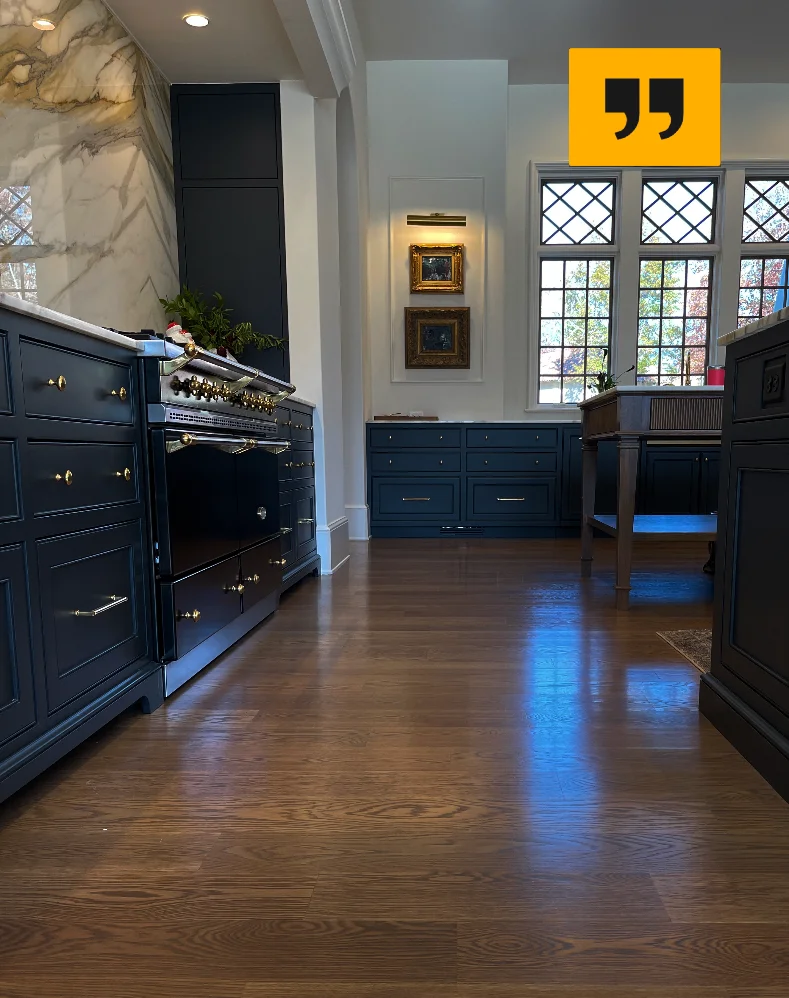
Buff and Re-Coat Hardwood Floors
Restore Luster and Protect Your Investment with Our Expert Services
Your hardwood floors are a highly visible aspect of the design of your home, office, or workplace. Left untreated, scratches, moisture and dents can not only diminish the natural beauty of your floors, but also damage the wood. Regular cleaning and preventative maintenance is essential to protect your investment and keep your floors looking their best.
We understand that caring for hardwood floors can be tedious, and you have other things to worry about.
That’s why Majestic Hardwood Floors offers comprehensive cleaning, polishing, buffing and other services customized to suit your needs.
For example, most floors benefit from periodic deep cleaning followed by a polish or Buff and coat hardwood floors. We always use the highest quality cleaning supplies sealers and materials and follow up with high-speed buffing machines to protect your floor’s finish as well as to bring forth its naturally beautiful shine.
For trouble spots or floors in poor condition, we also provide sanding and refinishing.
Majestic Harwood Floors – Your Top Choice for Exquisite Hardwood Flooring Solutions
Exquisite Hardwood Floors, Unmatched Craftsmanship Guaranteed.
Skilled Team, Flawless Hardwood Mastery.
Projects Completed
Combined Experience
Happy Customers
Projects Completed
Restoring hardwood floors without sanding is possible through a process known as screening and recoating. Here are the steps:
- Clean the Floor: Clean the hardwood floor thoroughly to remove dust, dirt, and residue. Use a pH-neutral cleaner to avoid any damage.
- Screening: Instead of sanding, use a floor buffer with a fine-grit sanding screen to lightly rub the existing finish. This smooths out imperfections without removing the entire finish.
- Vacuum and Tack Cloth: Vacuum the floor to remove debris from screening. Follow up with a tack cloth to ensure a clean surface for the new finish.
- Apply Finish: Use a compatible wood floor finish and apply it evenly across the floor. Allow it to dry completely between coats.
- Repeat if Necessary: If the floor requires additional smoothing or if you desire a higher sheen, repeat the screening and finishing process.
Resurfacing:
- Process: Involves lightly sanding and recoating the existing finish.
- Purpose: Addresses surface-level imperfections and adds a new protective layer.
- Suitability: Ideal for floors with minor wear or light scratches.
Refinishing:
- Process: Requires sanding down to the bare wood before applying a new finish.
- Purpose: Removes deeper scratches, stains, and damage, providing a more comprehensive restoration.
- Suitability: Suitable for floors with significant wear or damage.
The cost to refinish hardwood floors varies, but as a general guideline, it can range from $3 to $8 per square foot. Therefore, refinishing 1000 square feet of hardwood floors may cost between $3000 and $8000. Factors influencing the cost include the condition of the floors, the type of finish chosen, and regional labor rates.
Yes, refinishing hardwood floors is often cost-effective compared to replacing them. The cost of refinishing is typically lower than installing new flooring. Additionally, the process restores the original beauty of the wood, making it a worthwhile investment in preserving and enhancing the value of your home.
Recoating:
- Advantages: Quick, less expensive, and suitable for floors with minor wear.
- Limitations: Cannot address deep scratches or extensive damage.
Refinishing:
- Advantages: Comprehensive restoration, address deep damage, and provide a new finish.
- Considerations: It is more time-consuming and may be costlier than recoating.
Refinishing hardwood floors yourself can be worth it for those with DIY skills. However, consider the following:
- Experience: Refinishing requires skill; if you have experience, the results may be professional.
- Equipment: Renting or buying the necessary equipment can add to costs.
- Time: The process can be time-consuming, impacting daily routines.
- Risk of Damage: With proper knowledge, the floors can be protected.If you are confident in your skills and willing to invest time, DIY refinishing can be rewarding; otherwise, hiring a professional is advisable.
Refinishing hardwood floors should be avoided under certain conditions:
- High Humidity:
Refrain from refinishing during periods of high humidity. Excessive moisture in the air can affect the drying process of the finishes, leading to uneven results and potential adhesion issues.
- Extreme Temperature Fluctuations:
Avoid refinishing during extreme temperature fluctuations. Rapid temperature changes can impact the drying time and overall effectiveness of the refinishing process.
- Recent Water Damage:
If your hardwood floors have experienced recent water damage, it’s advisable to wait until the underlying issues are addressed. Refinishing on water-damaged wood can result in an uneven finish and may exacerbate existing problems.
- Unstable Subfloor:
Refinishing should only be undertaken if the subfloor beneath the hardwood is stable or damaged. Ensure that the subfloor is in good condition before proceeding with the refinishing process.
The ideal time to refinish hardwood floors is during moderate weather conditions, typically in the spring or fall. Here’s why:
- Optimal Humidity and Temperature:
Spring and fall generally offer moderate temperatures and humidity levels. This creates an ideal environment for the refinishing process, ensuring proper drying and adhesion of finishes.
- Ventilation:
Refinishing often involves the use of chemicals and finishes that emit odors. During mild weather, you can open windows and doors to facilitate ventilation, expelling fumes and ensuring a more comfortable living environment.
- Consistent Conditions:
Avoid extreme weather conditions, such as the peak of summer or the dead of winter, as these can lead to complications like extended drying times or improper curing of finishes.
The duration of sanding and refinishing hardwood floors depends on several factors, including the size of the area, the condition of the floors, and the number of coats applied. However, a general timeline is as follows:
- Sanding:
Sanding typically takes 1 to 3 days, depending on the extent of the work required. This process involves removing the existing finish and any imperfections from the wood.
- Staining (Optional):
If staining is part of the refinishing process, add a day for applying and drying the stain. Staining is optional and depends on your aesthetic preferences.
- Applying Finish:
Applying the finish usually takes 1 to 2 days, with drying time between coats. The number of coats applied can vary, with at least two coats recommended for durability.
- Drying and Curing:
After the final coat, allow 24 to 48 hours for the finish to dry and cure. During this time, avoiding walking on the floors or placing furniture is essential to prevent any damage.
To determine if your hardwood floors are waxed or polyurethane-finished, follow these steps:
Visual Inspection:
- Waxed Floors: Waxed floors often have a soft, matte appearance. It may be waxed if the surface looks slightly dull and can be buffed to a shine.
- Polyurethane Floors: Polyurethane-finished floors typically have a smoother, shinier surface with a more reflective finish.
Water Droplet Test:
- Waxed Floors: Place a few drops of water on the floor. If the water beads up, it’s likely a waxed finish.
- Polyurethane Floors: The water absorbed into the wood after a few minutes indicates a polyurethane finish.
Scratch Test:
- Waxed Floors: Lightly scratch an inconspicuous area with your fingernail. If a small white mark appears, it’s likely wax.
- Polyurethane Floors: Polyurethane finishes are more resistant to scratching, so if there’s no white mark, it’s likely polyurethane.
Historical Information:
- Waxed Floors: Older homes may have waxed floors, as wax was a common finish.
- Polyurethane Floors: Modern constructions often use polyurethane for its durability and low maintenance.
If uncertain, consult a flooring professional who can provide a more accurate assessment based on your floor’s specific characteristics.



